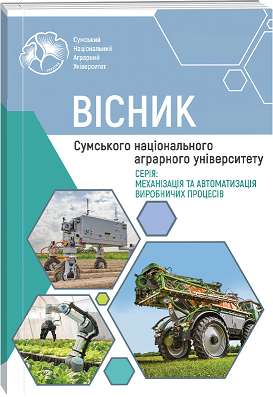ANALYSIS OF THE DEVELOPMENT OF MODERN MOBILE SYSTEMS FOR MONITORING SOIL CHARACTERISTICS
Abstract
In this paper, an analysis of existing methods and systems for collecting data on the inhomogeneity of soil conditions, in particular the hardness and location of compacted zones, both separately and directly during soil cultivation operations, was analyzed, their advantages and disadvantages were analyzed. In modern agricultural production, accurate digital maps of soil properties are necessary for the high-quality performance of soil cultivation operations. Scientists and equipment manufacturers are constantly improving existing systems for determining soil characteristics, which would allow creating accurate soil maps. Today, several types of sensors are used: electromagnetic, optical, mechanical, acoustic, etc. Among them, manufacturers mainly produce and widely use electromagnetic sensors. They collect information about soil heterogeneity, which makes it possible to define relatively constant and smaller areas in the field, which are called management zones. It is appropriate to use the data obtained as a result of electromagnetic scanning during movement on the field as one of the sources of information to determine the differences. In areas with similar electrical conductivity and with relatively stable yield, technological operations can be performed at the same modes of operation of units, which can be determined by a smaller number of samples. The creation of new sensors and systems capable of quickly changing the operating modes of machine units in real time will increase the efficiency of their use, thereby reducing the impact of soil differences on agricultural productivity. A promising direction is the use of mobile soil scanners, which will improve the quality and reduce the cost of creating soil maps. Further improvement of the process of soil analysis by sensors during movement will allow using the received data to adjust the operating modes of the units in real time. Currently, only electromagnetic mapping systems are available to agricultural producers on a commercial basis. Therefore, it is important to continue the development of new mobile systems for monitoring soil characteristics, which can be used by scientific and commercial institutions in the future. The main requirements for such systems are to increase the accuracy of data while reducing the cost of creating cartograms, which will facilitate the decision-making process.
References
2. Minasny, B., & McBratney, A. B. (2016). Digital soil mapping: A brief history and some lessons. Geoderma, 264, 301–311.
3. Omran, E. (2012). On-the-go digital soil mapping for precision agriculture. International Journal of Remote Sensing Applications, 2, 20–38.
4. Schreiner, S., Culibrk, D., Bandecchi, M., Gross, W., Middelmann, W. (2020). Soil monitoring for precision farming using hyperspectral remote sensing and soil sensors. At-Automatisierungstechnik, 69, 325–335. doi: 10.1515/auto-2020-0042
5. Viscarra Rossel, R. A., Adamchuk, V. I., Sudduth, K. A., McKenzie, N. J., & Lobsey, C. (2011). Proximal Soil Sensing: An Effective Approach for Soil Measurements in Space and Time. Advances in agronomy, 113, 237–282. doi: 10.1016/B978-0-12-386473-4.00010-5.
6. The topsoil mapper – know your soil – measures against soil compaction. (2023). Retrieved from https://www.topsoil-mapper.com/en/the-topsoil-mapper-know-your-soil/.
7. Veris Soil Scanner. Vantage agrometius. (2020). Retrieved from https://www.vantage-agrometius.nl/en/product/verisu-series-soil-scanner/.

 ISSN
ISSN  ISSN
ISSN 



